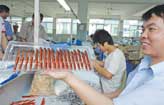China-US
Tapping more local potential
Updated: 2011-07-11 07:57
By Wu Chusheng (China Daily)
Cooperation and exchanges between China's provinces and US states and cities lay foundation for progress of relations
Under the co-sponsorship of the Chinese People's Association for Friendship with Foreign Countries and the United States National Governors Association, the first China-US Governors Forum is due to be convened in Salt Lake City, in the state of Utah in the US on Friday.
Officials from Zhejiang, Anhui, Yunnan and Qinghai provinces will lead delegations and exchange views with more than 40 US governors on a wide variety of topics, ranging from trade, investment and energy to environment and people-to-people exchanges.
Since the establishment of their diplomatic ties in 1979, friendly exchanges and cooperation between China and the US at the local level have propelled the broader development of bilateral relations. A total of 36 pairs of friendly relationships have so far been set up between the provinces of China and states in the US and a further 165 such links have been forged between cities in the two countries. Despite the occasional setbacks in bilateral ties over the past decades, mutually beneficial and reciprocal cooperation at the local level has managed to maintain a steady and rapid development momentum.
The Salt Lake City Forum was confirmed by President Hu Jintao and his US counterpart Barack Obama during the former's visit to the US in January and both countries hope to forge a platform to strengthen local bilateral cooperation, promote their common prosperity and further enrich the established Sino-US cooperative partnership.
Sino-US cooperation at local levels is expected to expand bilateral trade between the world's two largest economies. China and the US are complementary and both sides have strong demands for expanded economic and trade cooperation. The US is China's second largest export market and more direct cooperation between local regions in China and states in the US will open more unblocked channels for bilateral trade cooperation. China is now in a period of accelerated industrialization and urbanization, a process that means huge opportunities for US manufacturers. It is estimated that China will import more than $8 trillion worth of commodities over the next five years, an enormous market for US states. It is hoped that the ever-deepening local cooperation between the two countries will help the US federal government suspend its long-established restrictions on high-tech exports to China. These restrictions have been an obstacle in the way of the further development of bilateral economic and trade ties.
Expanded Sino-US cooperation at the local level will facilitate two-way investment between the two countries. Since reform and opening-up in 1978, China has made unremitting efforts to create a stable and transparent investment environment for foreign ventures and a number of US enterprises have thus come to China for business. At the same time, many Chinese enterprises have also actively established their business in the US, which has not only resulted in their economic build-up but also increased US employment and promoted local economic prosperity.
However, the deep-rooted hostility from some US conservative forces and interest groups toward investment from China has seriously hampered Chinese enterprises' investment in the US. Happily, quite a few US senators, governors and mayors are opposed to this and have expressed support for China's investment in their states. Under the current political system, US states have a great deal of power for economic self-initiatives and independence, which means that they can give a green light to investment from China.
The potential for cooperation between the two countries at the local level in green development and a low-carbon economy has yet to be fully tapped. A large wind power station co-funded by Shenyang Power Group and its US cooperative partner in Texas and the construction of a large photovoltaic power station by First Solar and its Chinese partners in Ordos, Inner Mongolia are both good examples of Sino-US energy cooperation.
It is reported that Qinghai province is poised to forge a green cooperative partnership with the state of Utah at the Salt Lake City forum. Undoubtedly, such expanded green cooperation at local levels will be a boost to sustainable development both in China and the US.
Expanded Sino-US local cooperation is also expected to stimulate the "Chinese language fever" in the US. So far, more than 70 Confucius Institutes and 200 Confucius classrooms have been set up in 44 US states and more than 4,000 primary and middle schools in the US have Chinese language courses.
The construction of the Sino-US cooperative partnership is an arduous and lengthy task and requires step-by-step work from both sides. The long-term institutionalized development of the China-US Governors Forum, which is already on the agenda of both sides, is expected to bring more tangible benefits to the peoples of both countries and inject a lasting and endurable vitality into the broader Sino-US relations.
The author is a Beijing-based observer of international issues.

Specials

90th anniversary of the CPC
The Party has been leading the country and people to prosperity.

The write stuff
'Pen capital' goes back to drawing board for answers to economic changes taking shape in Zhejiang

Say hello to hi panda
An unusual panda is the rising star in Europe's fashion circles